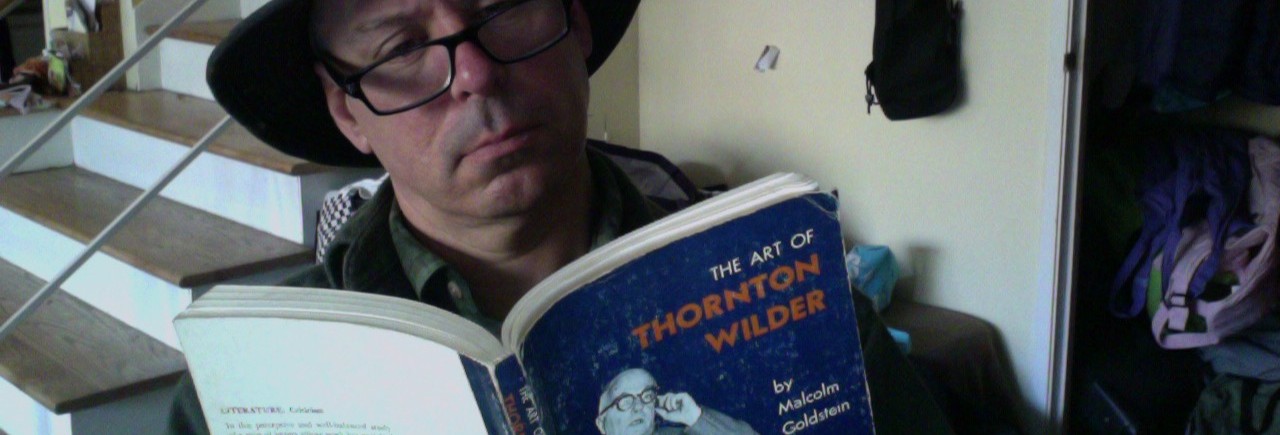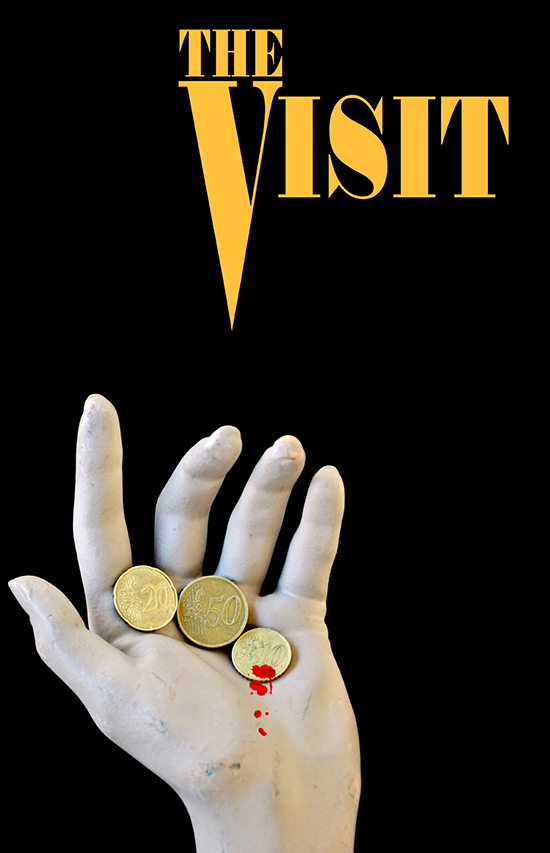The Visit
Presented by the Yale School of Drama through November 2 at the Iseman Theater, 1156 Chapel Street, New Haven. (203) 432-1234, www.yale
By Friedrich Dürrenmatt. Translated by Maurice Valency. Directed by Cole Lewis. Scenic Design: Montana Levi Blanco. Lighting Design: Caitlin Smith Rapoport. Sound Design: Brian Hickey. Projection Design: Kristen Ferguson. Production Design: Lauren Dubowski. Stage Manager: Emily DeNardis. Cast: Celeste Arias (Husbands, Mrs. Ill), Mamoudou Athie (Schoolmaster), Chris Bannow (Ill), Jabari Brisport (Painter, Gymnast, Brute, Sexton), Cornelius Davidson (Policeman, Man 2, Brute, Photographer), Ceci Fernandez (Bailiff, Eunuch, Daughter, Miss Louisa, Radio Commentator), Christopher Geary (Priest, Man 4), Merlin Huff (Doctor, Butcher), Sarah Krasnow (Brute, Woman 2, Reporter), Matthew McCollum (Mayor, Brute), Elia Monte-Brown (Butler), Mariko Nakasone (Claire Zachanassian), Iris O’Neill (Child, Gymnast, Granddaughter), Jennifer Schmidt (Brute, Woman 1), Mickey Theis (Station Master, Eunuch, Son, Man 3, Cameraman).
Dürrenmatt endures. Dürrenmatt matters.
It’s tempting to watch a well-managed, artistically inspired, thoroughly well acted and broadly entertaining production such as Cole Lewis’ vision of Dürrenmatt’s The Visit and connect it to the numerous solid ensemble work-outs by Brecht, Ibsen, Chekhov and even Shakespeare which get done at the Yale School of Drama on a fairly regular basis. It’s just as tempting to bring up Gogol as the type of antic, humor-infused yet essentially dark social satire to which shows like this aspire.
But that would be wrong. Theaters that have the resources and the intelligence to do Dürrenmatt should just do more Dürrenmatt, that’s all.
And they should do him now. Dürrenmatt’s dates are 1921-1990, with all of his theater writings happening in a short window from the late 1940s to the early 1980s. Yet there’s a century-spanning grandness to his work which places him among the immortals. Here’s another thing: his plays are balanced and fun to watch. They have deep messages, but also humor and melodrama and suspense. The Visit and The Physicists are beloved of college and small theaters, but in the 1960s summer stock theaters flocked to do the mock-courtroom mystery The Deadly Game, adapted by James Yaffe from Dürrenmatt’s novel Trapps.
All Dürrenmatt’s dramas have ever-timely provocative themes, even when he’s writing about ancient Greeks or Romans, or adapting Strindberg.
But some times are more timelier than others. Having just had our country teetering on a precipice of default and renewed recession, held ransom by crazed revenge-seekers seemingly oblivious to the disasters they leave in their wake—well, that’s not far off The Visit.
A woman returns to the small impoverished German town which she had to flee in despair and disgrace when she was a teen. She is now grotesquely wealthy, and offers a billion bucks (in older translations, it’s a million; inflation, you know) to the town and its inhabitants providing that someone kills the man who wronged her.
Depending on the playwright or director or actors, many different things could be done with that scenario. A lot depends on whether the offer is presented as genuine or outrageous. In Cole Lewis’ visceral and involving production, this is a political promise with endless social ramifications. The audience is constantly reminded that it can’t sit idly by when such things happen; that if we suspect corruption we are complicit in it. In this show, the audience is marched through the town before taking their seats. They are given little flags to wave.
Midshow, the color of those flags change, along with the general tone of the show. An amusing proposition has become a real promise, and threat. A community—our community—has gone from being appalled to becoming resigned and complacent and greedy. Talk of “Humanist traditions” has given to “Everything can be bought.”
The glory of Lewis’ production is in its naturalism and accessibility. The cast regularly addresses the audience informally. The special effects are inexpensively effective and direct: billows of smoke, projections, a small child. Everything’s a bit weird and off-putting. Brian Hickey’s brilliant sound design turns a train whistle into something like a scream and the sound of photo being snapped into a blurching oozing noise.
You can’t say this about a lot of ensemble shows, but the cast here benefits from its size and breadth. If you have been routinely attending shows at the School of Drama or the Yale Cabaret, you are aware that everyone in this 15-person ensemble is capable of carrying a show in a lead role. That they defer and modulate their performances here to serve the greater good, creating a thriving township, is notable. So is their ability to, without grandstanding, embody such fleeting characters as “Man 2,” “Cameraman” and “Sexton” with life, making these cameos memorable, is remarkable.
There are also, of course, leading roles. Chris Bannow has exactly the right air of amiability and irritability to play the flawed (and presumably morally redeemed), generally good-hearted Mr. Ill. As his former lover and current tormentor Claire Zachanassian, Mariko Nakasone gets grand entrances and some ultra-rich jet-setty comic shtick, but doesn’t descend into total cartoonishness. She pulls it all together gloriously for an intimate scene with her victim late in the play.
An inventive productive design makes it easy for scenes to shift rapidly. Locations are suggested by toy buildings. The characters need to be outdoors, and a swing drops from the heavens. Projections and props cover the rest. Nothing too fancy, just lots of basic items well used—including that hardy cast.
If there’s any deficiency in this production, it’s that Cole Lewis might have piled on a few ideas too many. The audience participation element is established, than utilized once or twice too often to my taste. It’s true, however, that as suspenseful and intense and engaging as The Visitors is, it’s a long play. Lewis and her ensemble simply aren’t taking any chances. Their attempts to banish any potential moments of boredom are appreciated and heartily acknowledged. Indeed, at the Wednesday night performance—a midweek night, for a three-hour show, when Game Six of the World Series was happening—showed almost not a single soul leaving during intermission.
This is high praise. Have a nice Visit.


Permalink
Wish I could have seen this production… A production I saw 47 years ago when I was a teenager at the Asolo Theater in Sarasota, Florida has stayed with me all these years. In fact, my interest in the theater as a profession was kindled by that production. It is a chilling, humorous, and haunting play. Even back when I saw my first production of the play, it was timely – differently than now but timely nonetheless.